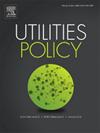Harnessing rooftop photovoltaic potential: Adoption disparities across building types in Tarragona Province, Spain
IF 4.4
3区 经济学
Q3 ENERGY & FUELS
引用次数: 0
Abstract
In recent decades, climate change and the global energy transition have prioritised renewable energy adoption. Rooftop photovoltaic (PV) systems have emerged as a promising solution, aligning with sustainability, decentralisation, and local energy production while efficiently using built spaces. Despite their potential, rooftop PV systems are still unevenly adopted due to technical and economic barriers. A lack of consistent data limits the ability to track adoption and support energy transition planning. This study focuses on Tarragona province (Spain) and assesses the solar PV potential of public and private buildings, including town halls, schools, libraries, and residential properties. Using GIS-based modelling and high-resolution geospatial data, including LiDAR-derived elevation models and cadastral records, we estimate that 38.72% of rooftops in the province meet suitable technical conditions for PV installation under a conservative scenario. A key contribution is the creation of a geolocated database of 18,577 rooftop PV installations through detailed photointerpretation, enabling spatial assessment of where systems have been deployed and how adoption varies by building type. Statistical analysis reveals contrasts in adoption, with residential buildings showing higher uptake, while public buildings adopted PV later. Results confirm that adoption is shaped by technical potential and sector-specific policy barriers. Findings suggest public buildings could foster broader PV uptake, leveraging peer effects and targeted incentives. This study highlights the need for accurate, publicly accessible PV installation databases to support energy planning, especially in urban and mixed-use areas. By clarifying PV adoption dynamics, this research supports informed policymaking for a more equitable, effective energy transition.
利用屋顶光伏潜力:西班牙塔拉戈纳省不同建筑类型的采用差异
近几十年来,气候变化和全球能源转型已成为采用可再生能源的优先事项。屋顶光伏(PV)系统已经成为一种很有前途的解决方案,它与可持续性、分散化和当地能源生产相一致,同时有效地利用了建筑空间。尽管具有潜力,但由于技术和经济障碍,屋顶光伏系统的采用仍然不均衡。缺乏一致的数据限制了跟踪采用情况和支持能源转型规划的能力。本研究的重点是西班牙塔拉戈纳省,并评估了公共和私人建筑的太阳能光伏潜力,包括市政厅、学校、图书馆和住宅物业。利用基于gis的建模和高分辨率地理空间数据,包括激光雷达衍生的高程模型和地籍记录,我们估计在保守情景下,该省38.72%的屋顶满足光伏安装的合适技术条件。一个关键的贡献是通过详细的照片解释创建了18577个屋顶光伏装置的地理定位数据库,从而能够对系统部署的位置以及不同建筑类型的采用情况进行空间评估。统计分析揭示了采用率的差异,住宅建筑采用率较高,而公共建筑采用率较晚。结果证实,采用率受到技术潜力和特定部门政策障碍的影响。研究结果表明,公共建筑可以利用同行效应和有针对性的激励措施,促进更广泛的光伏应用。这项研究强调了对准确的、可公开访问的光伏安装数据库的需求,以支持能源规划,特别是在城市和混合用途地区。通过澄清光伏采用动态,本研究支持制定更公平、更有效的能源转型政策。
本文章由计算机程序翻译,如有差异,请以英文原文为准。
求助全文
约1分钟内获得全文
求助全文
来源期刊

Utilities Policy
ENERGY & FUELS-ENVIRONMENTAL SCIENCES
CiteScore
6.80
自引率
10.00%
发文量
94
审稿时长
66 days
期刊介绍:
Utilities Policy is deliberately international, interdisciplinary, and intersectoral. Articles address utility trends and issues in both developed and developing economies. Authors and reviewers come from various disciplines, including economics, political science, sociology, law, finance, accounting, management, and engineering. Areas of focus include the utility and network industries providing essential electricity, natural gas, water and wastewater, solid waste, communications, broadband, postal, and public transportation services.
Utilities Policy invites submissions that apply various quantitative and qualitative methods. Contributions are welcome from both established and emerging scholars as well as accomplished practitioners. Interdisciplinary, comparative, and applied works are encouraged. Submissions to the journal should have a clear focus on governance, performance, and/or analysis of public utilities with an aim toward informing the policymaking process and providing recommendations as appropriate. Relevant topics and issues include but are not limited to industry structures and ownership, market design and dynamics, economic development, resource planning, system modeling, accounting and finance, infrastructure investment, supply and demand efficiency, strategic management and productivity, network operations and integration, supply chains, adaptation and flexibility, service-quality standards, benchmarking and metrics, benefit-cost analysis, behavior and incentives, pricing and demand response, economic and environmental regulation, regulatory performance and impact, restructuring and deregulation, and policy institutions.
 求助内容:
求助内容: 应助结果提醒方式:
应助结果提醒方式:


